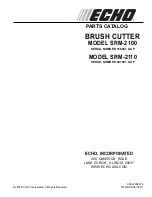
j) Wear personal protective equipment. Depending on
application, use face shield, safety goggles or safety
glasses. As appropriate, wear dust mask, hearing
protectors, gloves and shop apron capable of
stopping small abrasive or workpiece fragments.
The eye protection must be cap-able of stopping flying
debris generated by various operations. The dust mask
or respirator must be capable of filtrating particles
generated by your operation. Prolonged exposure to
high intensity noise may cause hearing loss.
k) Keep bystanders a safe distance away from work
area. Anyone entering the work area must wear
personal protective equipment.
Fragments of
workpiece or of a broken wheel may fly away and cause
injury beyond immediate area of operation.
l) Hold the power tool by insulated gripping surfaces
only, when performing an operation where the
cutting accessory may contact hidden wiring or its
own cord.
Cutting accessory contacting a "live" wire
may make exposed metal parts of the power tool "live"
and could give the operator an electric shock.
m) Position the cord clear of the spinning accessory.
If
you lose control, the cord may be cut or snagged and
your hand or arm may be pulled into the spinning wheel.
n) Never lay the power tool down until the accessory
has come to a complete stop.
The spinning wheel may
grab the surface and pull the power tool out of your
control.
o) Do not run the power tool while carrying it at your
side.
Accidental contact with the spinning accessory
could snag your clothing, pulling the accessory into your
body.
p) Regularly clean the power tool’s air vents.
The
motor’s fan will draw the dust inside the housing and
excessive accumulation of powdered metal may cause
electrical hazards.
q) Do not operate the power tool near flammable
materials.
Sparks could ignite these materials.
r) Do not use accessories that require liquid coolants.
Using water or other liquid coolants may result in
electrocution or shock.
Additional Safety Precautions for Marble
Cutters
Warning:
Never use the damaged hoses and
other critical parts.
Keep liquid clear off the parts of the tool and
away from persons in the working area.
Caution!
Do not touch exposed metal parts of the
tool when cutting through walls and floors, or
when in contact with electrical wiring! Hold the
tool by insulated gripping surfaces when
performing an operation where the cutting tool may come in
contact with concealed wiring or its own cord. Contact with a
"live" wire will make exposed metal parts of the tool "live" and
this will cause electric shock to the operator.
1. Always keep your hands away from the cut ting area
and the diamond wheel. Always keep the other hand
on the side handle.
If you hold the tool with both hands,
you will not be injured by the wheel.
2. Do not touch the underside of the work piece
because
the guard cannot protect the part of the wheel under the
workpiece.
3. Always use a diamond wheel with well-matched size
and center (diamond or circular shape).
Mismatched
wheel and holder will result in eccentric operation and you
may lose control.
4. Do not use any washer or bolt that is dam aged or
unfit in size;
otherwise you will lose control of the
operation.
5. Do not use any grinding wheel.
6. Do not use any diamond wheel that does not conform
to the manufacturer's stipulations.
7. Do not use any cutting wheel that has been
damaged, distorted, or cracked.
8. Do not operate the tool without the fixed guard.
9. Do not start the tool with the cutting wheel touching
the workpiece.
10. After switching off the tool, put down the tool only
after the cutting wheel has com pletely stopped
running. Do not force the wheel to stop.
11. Disconnect the plug from the power source and
ensure that the diamond wheel is stationary before
replacing it, adjusting the tool.
5
ENGLISH






































